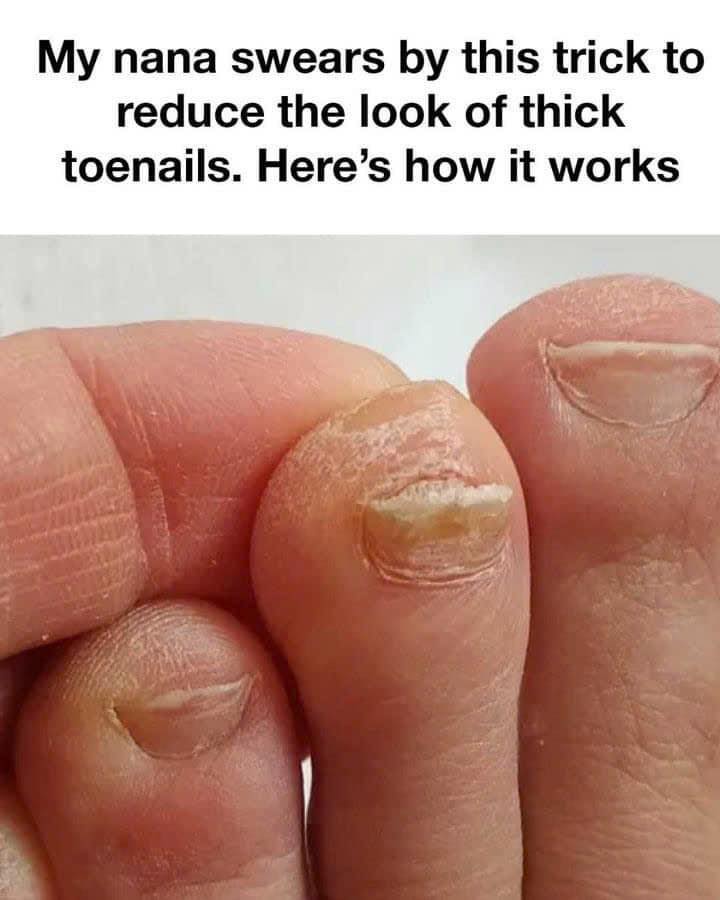Toenail problems are more common than many people think, affecting individuals across various age groups. These issues can range from discoloration to thickening, often causing discomfort and raising health concerns. While thickened toenails might seem like a purely cosmetic issue, they can sometimes indicate underlying health conditions that require attention. Although there are numerous medical treatments available, simple home remedies can often be a practical starting point. My grandmother, who is well-versed in traditional remedies, has shared an easy and effective technique to improve the appearance of thick toenails. This method uses everyday household items and emphasizes consistency and care.

Thick toenails may develop for a variety of reasons, including fungal infections, aging, physical trauma, psoriasis, or poor blood circulation. Each of these causes requires proper attention, and understanding the underlying issue is critical. However, when it comes to improving their appearance, some simple steps can make a significant difference.
Understanding the Causes of Thick Toenails
Before delving into remedies, it’s important to recognize why thick toenails occur. Fungal infections are a common culprit, but other factors such as injuries or even the natural aging process can contribute to this issue. Inadequate blood flow to the feet, often caused by conditions like diabetes, can also play a role. Additionally, psoriasis and other skin conditions might extend to the nails, causing thickening and discoloration. Addressing the root cause is always essential, but improving the toenail’s appearance can enhance comfort and confidence in the meantime.
My Grandmother’s Simple Remedy for Thick Toenails
My grandmother’s approach to thick toenails involves a straightforward, non-invasive method that anyone can try at home. Her technique relies on softening and exfoliating the nails while keeping the surrounding skin healthy and hydrated. This regimen uses common household items and avoids the need for harsh chemicals or expensive treatments.
To get started, gather the following ingredients and tools:
- Warm water
- White vinegar
- Baking soda
- A basin or container large enough for soaking feet
- A soft-bristled nail brush
- A pumice stone or nail file
- Moisturizing lotion or oil
Step-by-Step Instructions
- Warm Water Soak: Begin by filling a basin with warm water and adding half a cup of white vinegar. Soak your feet in this solution for 20 minutes. The warm water softens the nails, while the vinegar provides mild antimicrobial properties that can help reduce fungal growth.
- Gentle Scrubbing: After soaking, use a soft-bristled nail brush to gently scrub your toenails and the surrounding skin. This helps remove debris and further softens the nail surface, preparing it for the next steps.
- Baking Soda Paste: Rinse your feet and create a paste using baking soda and a few drops of water. Apply this paste to your toenails and let it sit for about 10 minutes. Baking soda acts as a gentle exfoliant, helping to smooth the surface of the nails.
- Filing the Nails: Once the paste has been rinsed off, carefully use a pumice stone or a nail file to reduce the thickness of your toenails. Be cautious not to file too aggressively, as this could cause damage to the nail or surrounding skin.
- Moisturizing: Finish by applying a moisturizing lotion or oil to the toenails and surrounding skin. This step helps keep the area hydrated and promotes healthy nail growth over time.
How This Method Works
The elements of this remedy work together to improve the condition and appearance of thick toenails. The vinegar soak softens the nails and provides mild antimicrobial benefits. Baking soda gently exfoliates the nail surface, removing buildup and discoloration. Filing the nails reduces their thickness gradually, while moisturizing helps maintain hydration and prevents cracks or further thickening.
Additional Tips for Toenail Health
To maintain healthy toenails, follow these essential practices:
- Keep your feet clean and dry to minimize the risk of fungal infections.
- Trim your toenails regularly and straight across to avoid ingrown nails.
- Wear breathable footwear and moisture-wicking socks to prevent excessive sweating.
- Engage in regular exercise to promote healthy blood circulation.
- Monitor your toenails for any changes in color, thickness, or texture, as these could indicate an underlying issue.
When to Seek Professional Help
While home remedies like my grandmother’s method can be effective, certain cases may require professional intervention. If you experience persistent pain, severe thickening, or unusual discoloration, consult a doctor or podiatrist. Conditions such as advanced fungal infections or psoriasis often need prescription medications or specialized treatments.
Conclusion: Embracing Healthier Toenails
Thick toenails don’t have to be a constant source of discomfort or embarrassment. By adopting simple home remedies, such as the technique recommended by my grandmother, you can significantly enhance the appearance and health of your toenails. Consistent foot care, combined with these natural methods, can lead to healthier, more comfortable toenails over time. Always stay attentive to changes in your feet and toenails, and seek professional advice if necessary. Through proper care and attention, you can step forward with confidence and comfort.





